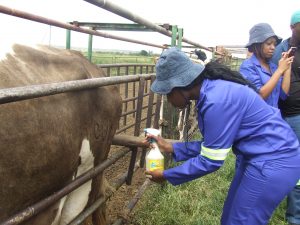
Northern farmers benefit from community project
Livestock farmers in the Northern Communal Areas have so far ripped fruits from a community based project that was established to improve the income of the farmers.
The Northern Communal Areas including Zambezi region is home to more than 60% of the country’s population,the majority of whom depend largely on livestock and crop farming for their daily sustenance. The area contains nearly 50% of the cattle and 54% of the total goat populations in the country and currently has a population of 1.4 million cattle, 707 000 goats and 66 000 sheep.
According to Hon. Minister of Agriculture, Water and Forestry John Mutorwa, the phenomenal growth in the livestock population has resulted in increased pressure on grazing and watering resources, leading to environmental degradation in some areas. The situation has further been compounded by limited marketing options for farmers.
In order to address these challenges, a four year project called the Community Based Rangeland and Livestock Management (CBRLM) project was set up to improve the income of the livestock farmers in the 7 Northern Communal Areas. The project has been implemented in 58 selected grazing areas, benefiting 15 00 households through community development, rangeland management, livestock improvement, training and livestock marketing.
Through the CBRLM project, farmers agree to combine individual herds into large herds, plan grazing routines and herd the livestock together every day. This Planned Grazing and Combined Herding has resulted in improvement of soil and pastures in the project intervention areas. Farmers are also taught to manage livestock farming as business entities.
The Ministry of Agriculture, Water and Forestry and its development partner, the Millenium Challenge Account Namibia (MCA-N) have invested in the development of human resources, veterinary and marketing infrastructure and disease surveillance in areas prone to Foot and Mouth Disease (FMD).
A network of veterinary clinics, offices and staff accommodation and animal health border check-points are currently being constructed in the Northern Communal Areas. In addition, 5 government owned abattoirs are also being upgraded and cold storage facilities as well as meat processing plants are being set up in these areas. At least 70 water points have also been constructed in these areas.
“We will soon be constructing a regional diagnostic laboratory at Ondangwa and a research facility at Enhana. We have also significantly improved the research and diagnostic capacity of the Central Veterinary Laboratory in Windhoek, which is now able to undertake advanced, cutting edge diagnostic procedures,” said Mutorwa. He added that livestock identification and traceability was extended to the Northern Communal Areas over the last 3 years with ear-tagging and registration of livestock into a national computerized database.
The CBRLM project is implemented in Kavango East, Kavango West, Ohangwena, Oshikoto, Oshana, Omusati and Kunene regions and will come to an end in July 2014.











































